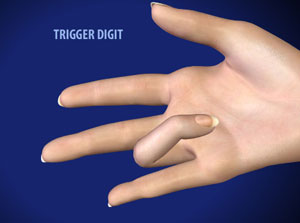Trigger Finger
What it is

The formal name of a trigger finger is Stenosing Tenosynovitis. It is caused by swelling around the tendon or tendon sheath (tunnel the tendon runs in) and typically effects the tendons which flex your fingers or thumb. It is more common in patients with Diabetes.
Symptoms
Patients usually notice clicking or locking of the finger as well as pain at the base of the finger where most of the swelling and irritation occurs. A nodule can form on the tendon as a result of the swelling and can sometimes be felt by palpation. It is this nodule sliding through the tendon sheath that gets stuck and causes the triggering. For many people, symptoms are worse in the morning upon waking and may change in severity depending on use of the hand.
Non Surgical Treatment
Trigger fingers are initially addressed with non surgical treatments. The best option is a cortisone injection around the tendon sheath, which decreases the pain and swelling so that the tendon can glide more smoothly. This has proven to be successful in about 60% of people and can simply be performed in the office. Occasionally a second injection is needed if the symptoms do not resolve completely or they return after a period of relief.
Surgical Treatment
For patients in whom non surgical treatment does not work, a simple surgery may be indicated. Trigger Finger Release is performed in an outpatient surgery center and takes about 10-20 minutes to perform. A local anesthesia (injection of numbing medicine) is used while the patient is either wide awake or sedated. A general anesthesia is not required. The procedure includes a small incision in the palm through which the tendon sheath is released in order to allow the tendon to glide without getting stuck. The wound is closed with a few stitches and the hand is placed in a soft dressing which allows finger movement.
Post-operative Recovery
Patients are allowed to move their finger immediately. A follow up appointment with your surgeon is made about 10-14 days after surgery for removal of the stitches. Recovery of hand function is usually very quick and soreness in the hand with gripping/lifting usually resolves in 4-6 weeks.
If these symptoms sound familiar to you, give our office a call at 715-907-0900 to schedule an appointment.
All Images Copyright American Society for Surgery of the Hand

Trigger Digit Release
During this minimally-invasive procedure, the surgeon opens a narrowed tendon pulley at the base of a finger or thumb affected by trigger digit. Opening the pulley prevents the nodule from catching, allowing the the affected digit to flex and extend normally with no triggering or pain.
